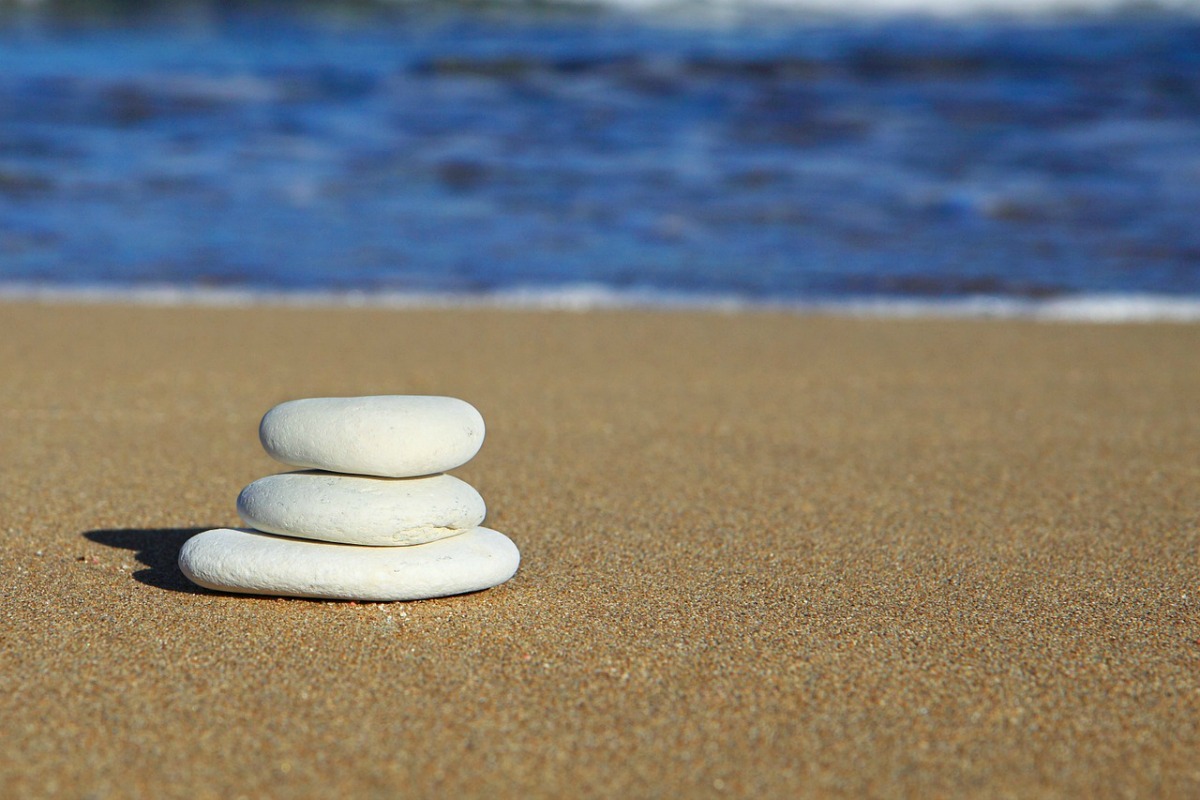
Tips on Balancing the Throat Chakra
As we have moved up the body and looked at the main chakras: the root, sacral, solar plexus, and heart, we now encounter the fifth major chakra located at the throat. We’ve learned that in the Eastern traditions, the chakras are our energy centers and each is attached to certain areas of the body. For us to remain well, the chakras should be balanced, and one is often dependent on the state of the balance of those below or above it.
The fifth or throat chakra resides in the throat region of the body and includes the neck, shoulders, jaw, esophagus, vocal cords, trachea and up to the ears, thyroid, and parathyroid. Its color is blue, which can be light blue, dark blue, or turquoise depending on your first teacher.

It is called Vishuddha in Sanskrit which means purity or purification. Commonly its elements are considered to be ether or space, the sky, and sound. The sense associated with the Vishuddha is that of hearing.
This chakra is all about communication, openness, honesty, and purity of speech. Speech, it is believed, shows intelligence for us to make the right choices and gives us willpower, self-expression, and the right to speak and be heard in truth and harmony. Often it is believed to be the crossover between the heart and subconscious.
The fifth chakra gives us an appreciation of all things beautiful and helps with our artistry in whatever form we have—painting, dancing, singing, writing, sculpting, or drawing. From here we gain the inspiration for this part of us to come forward in order to share with the rest of the world.
Communication is another large part of the fifth chakra. Both the ability to speak (in truth) but also the other side of communication…that of listening, which is far more difficult for most of us!
When the throat chakra is balanced, we are expressive and communicative, our creative imaginations are sparked and ready for action. The speakers we enjoy engage us through truth and laughter and have a highly developed fifth chakra. We know they are really listening to us, not merely planning on what they are going to say next.
To people with a well-balanced fifth chakra, lies and dishonesty cannot be tolerated—they are abhorrent to them. If you know someone who won’t (or can’t in some circumstances) listen to some opinions or politicians, it is generally their fifth chakra detecting untruths. These people can only be truthful, and are deeply offended when they see dishonesty in others, especially in those they care about. They simply cannot understand another being lying to them.
Their gratitude for the world around them, and to those close about is obvious to all. These people are often telepathic and have a quick grasp of what is going on around them, even at a global level. They can see several outcomes immediately when put in a difficult position and instinctively take the correct one, and all that analysis happens in their heads in a blink of an eye.

These are the folks who have faith, strong will power, a large vocabulary, and courage. The communication line between the heart and the mind is developed and balanced.
You’ll find good speakers here, teachers and storytellers who all have strong throat chakras. They are a pleasure to listen to. They rarely use toxic language, but find far more creative words to express themselves!
When this chakra is blocked, look for the inability to express oneself, shyness often with feelings of powerlessness. Their voices are weak and they abhor public speaking. When they do speak, much of what they say is skewed or gossip as their integrity is often not a strong point.
Other possible signs that might be indicative of a poorly balanced fifth chakra include sore throats, teeth clenching, jaw tightening, ear infections, speech problems, or eating disorders.
As with the other chakras, an imbalance can be manifested with indications of excess or a deficiency in the area.
How to know when the throat chakra is unbalanced to the excess:
- The “know it all” attitude
- Arrogance, self-righteousness
- Sexually dominant
- Long winded or a lot of words and no content
- They have to have the last word (we all know one or two of those!)
- They’re void of inspiration or any artistic output
- Gossipy
- They are very poor listeners, often interrupting, and raising their voices to be forcefully heard
When the throat chakra is deficient:
- Shy, timid
- Terrified of public speaking
- Whiners
- No inflection in their speech
- Afraid of sex
- Manipulative
- Often tone deaf
- Limited vocabularies
- Loud noises upset them
So how do we attempt to bring an unbalanced fifth chakra into balance? I like to start with nutrition. (Hippocrates said “Let your food be your medicine and your medicine be your food!)
Tips on Balancing the Throat Chakra

Diet
Start with eating blue foods:
- Blueberries
- Blackberries
- Currents
- Grapes
- Plums
- Elderberries
- Raisins
- Black olives
- Purple/red cabbage
Blue, purple and red foods contain phytochemicals that are responsible for those color pigmentations. These indicate flavonoids and that means antioxidants that help our immune systems among a long list of other attributes. They contain vitamin C and fiber, both helpful to general heath.
Grains for this chakra include barley and wheatgrass.
Since the fifth chakra also includes the thyroid, sea vegetables are helpful; they contain iodine which is crucial for proper thyroid function. (Do you remember your great-grandmothers and their goiters? It may have been due to a lack of iodine which was rectified years ago by adding iodine to salt. I have recently noticed that grocery store sea salt now has iodine added.)
Herbs
Among the herbs that might be beneficial are anything used to help with sore throats such as: marshmallow, slippery elm, and lemons. Rosemary, thyme, or sage used in herbal steams and inhaled also appear to strengthen the area. Gargling with thyme tea may be helpful for sore throats.

Aromatherapy
Aromatherapy is another modality that may be supportive for balancing your fifth chakra. As with herbs, essential oils for a chakra are chosen for their affinity for a certain part of the body, for an emotional condition (remaining calm so one can speak with clarity and objectivity), or for their color.
The following are some essential oils you may want to consider. You can use these (diluted to 3% in a carrier oil) on your pulse points, or on a cotton ball or in a diffuser for inhalation. Adding them (diluted in a carrier oil) to a bath and relaxing in low lights and soft music can be very stress relieving. I often add essential oils to Dead Sea salts and put them in my bath. My favorite blend is 4 drops lavender (Lavandula angustifolia), 11 drops of chamomile (Matricaria recutita), and a drop of peppermint (Mentha x piperita) or spearmint (Mentha spicata). First blend the essential oils with 1 tablespoon of carrier oil, then mix with 1 ½ cups of Dead Sea salts. Use ½ cup of this mixture per bath.
Essential oils to consider:
- Rosemary (Rosmarinus officinalis) – blue flowers
- Thyme (Thymus vulgaris) – in vaporizer or steam for the throat
- Cedarwood (Juniperus virginiana) – helps the immune system
- Lavender (Lavandula angustifolia) – calming
- Geranium (Pelargonium graveolens) – in vaporizer or steam for the throat
- Coriander (Coriandrum sativum) – calming and focusing
- German chamomile (Matricaria recutita) – calming beautiful blue oil
- Grapefruit (Citrus paradisi) – with geranium in a vaporizer or steam for the throat
- Indian Champa – this is not an essential oil, but this traditional scent from India comes as a perfume oil or incense (also in soaps, candles and room sprays). I was given the oil by my mentor to be inhaled prior to speaking to clear my mind and make my “words pure.”
Essential Oil Safety Notes (from Tisserand & Young, 2014)
Rosemary: do not use on or near the face of infants or young children.
Thyme: the thymol chemotype can be a skin and mucous membrane irritant and is contraindicated before major surgery, when taking anticoagulant medications, or for any bleeding issue. Use in low doses, such as 1 drop or less for a steam. The linalool chemotype is more gentle.
Grapefruit: phototoxicity risk. If use for steam, stay out of the sun or other source of UV radiation for 12 hours.
Meditation
Meditation in a quiet place outside (a forest or meadow versus next to a super highway) under a blue sky is always of help. Since sound is an important element of this chakra, sit quietly and just listen. Identify what you hear, both close by and in the distance. Keep your eyes closed and just listen. Are the birds chirping? Do you hear the crickets? Is someone’s lawnmower running?
Visualizations you can use when sitting quietly outdoors under a blue sky, or near a blue body of water, or meditating include: visualizing a blue light coming down from the sky and encompassing you, feel it saturate your body. Breath in the blue air, hold it for a few seconds giving it time to gather toxins and then breath out watching as blockages and negativities are removed. Those who study color therapies feel that blue is analgesic and calming.
These meditations/visualizations are beneficial to artists prior to picking up a brush, or for writers with writer’s block!
Holding your thumbs over your ears and humming might help as well.
Singing and dancing are great ways to rebalance the fifth chakra and can work on several other chakras at the same time.

Those into yoga, try these positions:
- Plow pose
- Fish pose
- Bridge pose
- Lion pose
- Camel pose
- Bow pose
When you’re tense (and maybe not yoga-literate) try doing neck stretches—gently go back and forth and side to side. Placing your hands on your shoulders sometimes can help if you find the area that is tense and then you can self-massage. Find a good book on trigger points or acupressure if this interests you, and look for the pressure points.
Affirmations
- I am both a teacher and a student.
- I speak the truth.
- My word can be relied upon.
- I hear all the sounds of the universe.
- I listen to guidance from the unseen.
The Vishuddha chakra is all about purity—in speech, in actions, in interactions, and in self-expression. When we’re balanced we feel independent and secure about ourselves and we’re interested in helping others.
Throat Chakra Balancing Recipes
Here are two of my go to recipes when my fifth chakra isn’t quite balanced:
Slippery Elm Balls
Slippery elm powder
Raw honey
- Mix powdered slippery elm with enough honey until you can form little balls nearly the size of a small marble.
- Coat these with more slippery elm and store in a small airtight jar until needed.
- I’ve used them successfully for sore throats and acid reflux.

Elderberry Syrup
There are many different types of elderberry syrup recipes. This is the one I find the easiest fit for my lifestyle.
½ cup dried elderberries
Stick of cinnamon
Cloves (5-10)
Ginger (a few quarter sized slices)
4 cups of water
- Combine all ingredients and bring to a boil.
- Cover pan and turn off heat.
- Let sit overnight.
- The next morning, bring to a boil and simmer for 30 minutes, covered.
- Strain.
- Add honey to taste (I use a couple tablespoons)
- Add a dash of vanilla (optional).
Next month we’ll learn about our “third eye” or sixth chakra.
REFERENCES:
Tisserand, R. & Young, R. (2014). Essential oil safety. London, UK: Elsevier.








